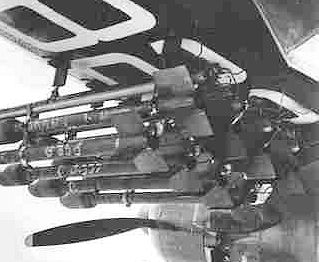My Tour with 84 Sqdn in Malaya Jun-Dec 1950
My second sortie on board a Bristol Brigand (see photo) was on the following Wednesday June 28th 1950 when the Sqdn. was engaged in operations from 26th together with 45 Sqdn and Six Spitfires from No: 60 Sqdn, all based at Tengah. in an exercise named 'Blue Road' where the aircraft joined forces over three days carrying out 'dummy' attacks on a cruiser. On the third and final day an exercise with the combined naval Sqdn. including the 'I.N.S. Delhi' (Indian Naval Ship) took place including the firing of RP's (Rocket Projectiles) and cannons onto a towed target.
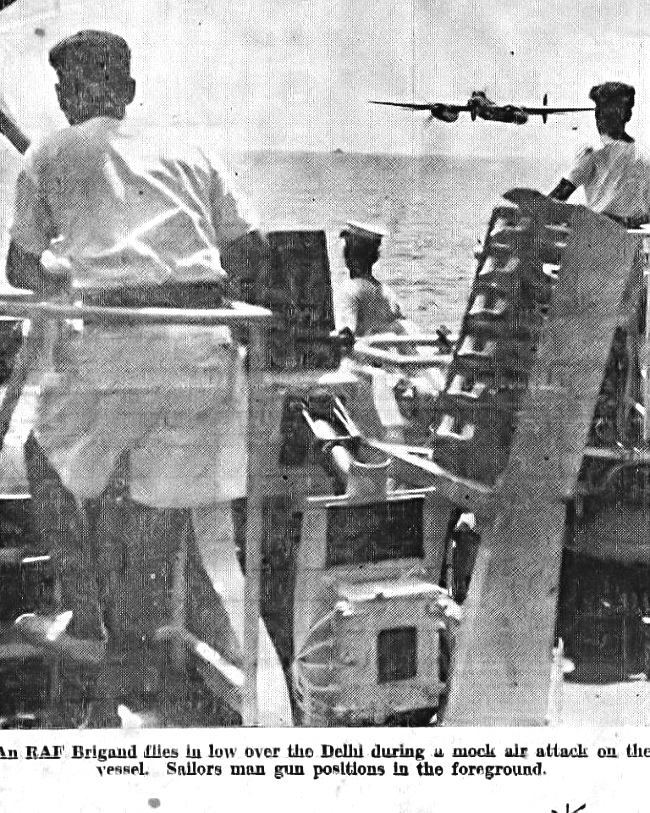 At 0730 hrs Allan Limbert and I took off from Tengah in Brigand RH815 and on reaching the shipping moved into position to commence an attack using our dive brakes to decrease our speed and increase the angle of attack. These brakes are controlled by a lever marked 'Open' and 'Shut'. On moving the lever to the 'open' position the port side one collapsed, fortunately Allan was able immediately to return the lever to the 'closed' position and stop the plane rolling over and sending us all into a watery grave. On return to Tengah it was found that the fabric on the dive brake bellows was subject to wear and tear and porosity in the humid conditions and so as from that day these were disconnected.
At 0730 hrs Allan Limbert and I took off from Tengah in Brigand RH815 and on reaching the shipping moved into position to commence an attack using our dive brakes to decrease our speed and increase the angle of attack. These brakes are controlled by a lever marked 'Open' and 'Shut'. On moving the lever to the 'open' position the port side one collapsed, fortunately Allan was able immediately to return the lever to the 'closed' position and stop the plane rolling over and sending us all into a watery grave. On return to Tengah it was found that the fabric on the dive brake bellows was subject to wear and tear and porosity in the humid conditions and so as from that day these were disconnected.
By 1010 hrs I was airborne again in RH815 to carry out a water pipe line patrol along a large diameter pipe that came above the ground in the Johore State and crossed the 'causeway' to Singapore Island bringing fresh water to the Island. This exercise was to help prevent the C.T.'s blowing up the pipeline? This flight usually lasted for 35 minutes and the following day I carried out the same exercise. (see newspaper article)
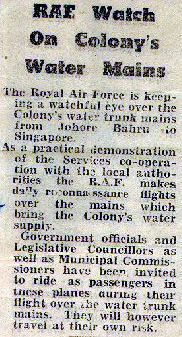 On 3rd July I went on my first air-strike, this trip with the C.O. in RH816, using a target map showing mainly contours, spot heights, villages etc. with the target marked. Usually all you could see was dense jungle and getting to the target consisted of concentrated map reading. Our Brigand carried 2 x 1000lb bombs under the fuselage. 1-500lb bomb under each wing and 6 - 60lb rockets. After doing our bombing runs we fired the rockets in salvo of two's finishing up by strafing the area with cannon fire. The Flight lasted two hours and apart from seeing the bomb bursts and the rocket trails nothing else could be seen and the jungle returned to its lush, dense self as we headed back to base.
On 3rd July I went on my first air-strike, this trip with the C.O. in RH816, using a target map showing mainly contours, spot heights, villages etc. with the target marked. Usually all you could see was dense jungle and getting to the target consisted of concentrated map reading. Our Brigand carried 2 x 1000lb bombs under the fuselage. 1-500lb bomb under each wing and 6 - 60lb rockets. After doing our bombing runs we fired the rockets in salvo of two's finishing up by strafing the area with cannon fire. The Flight lasted two hours and apart from seeing the bomb bursts and the rocket trails nothing else could be seen and the jungle returned to its lush, dense self as we headed back to base.
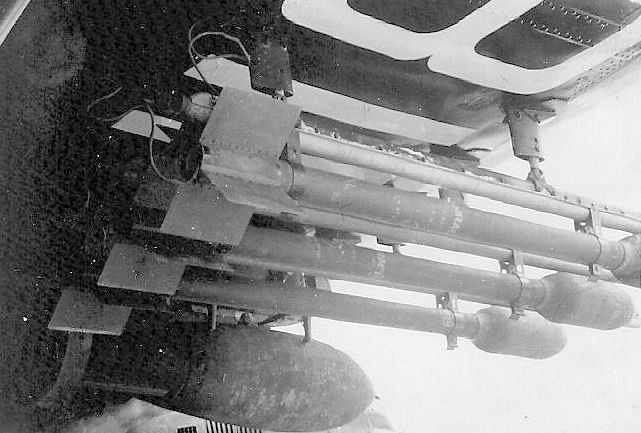
During July 1950 I went on a further 8-air strikes. At this time it was found that the aircraft skin was splitting around the housing for the bomb hoist hook at the nose of the plane so instead of 2-1000lb bombs being carried beneath the fuselage this was reduced to 1-1000lb bomb with one 500lb bomb at the nose.
On July 6th a Brigand and its crew from 45 Sqdn. crashed in the jungle whilst carrying out a strike in Northern Malaya and burnt out. The crew of three perished.
On Monday 31st July a relay of Brigands were to take part in 'Operation Swan-song' which was to give aerial cover to a convoy of school children going by road from the Cameron Highlands to Tapah to start their summer holiday back home.
The first Brigand RH815 containing a crew of three, a Flt. Lt. Pilot, a Flt. Lt. Navigator (both who had been in the Sqdn. since its re-organisation in Iraq) and a Sgt Signaller, took off from Tengah at 0900 hours with a normal load of fuel, 6-rockets and ammunition for its 4 cannons and arrived over the Cameron Highlands golf course at 10.02hrs, making contact with the Air Control Team by VHF. As the time for the convoy to move off was not until 10.35hrs, the Pilot gave a display of low flying and steep turns amongst the hills and valleys surrounding the golf course for the benefit of the school children and their army escort. When the convoy moved off the aircraft began its escort duties flying ahead of the convoy, reporting the road clear, making dummy attacks and flying between 150 and 200 ft. He was in frequent touch with the Air Contact Team. A few minutes before 11.00 hrs he overtook the convoy on the starboard side at about 400 ft, and flew down the valley in a shallow dive going below the level of the road. He then made a steep turn to port in a valley ahead of the convoy, he headed back to the leading vehicles climbing up directly towards them from the valley below. Half a mile from the leading vehicle he commenced a steep climb but failed to clear the slopes of a hill to port of the lead vehicles. The aircraft struck a bushy top of a tree on the side of the hill about 150ft above the road. , the aircraft was damaged, including damage at the nose and port wing tip as it passed through the top of a tree and shed pieces along its path over the road. The aircraft then climbed steeply to about 500ft above the road, stalled and dived vertically into the jungle covered slopes of the hill approximately 100 yards from the road.
The position of the accident is recorded as 04degrees28'N 101degrees 22E near the 35th mile marker on the Tapah - Cameron Highland Road. 100 yards from the road in the jungle.
At 0915hrs on August 4th F/O Macpherson and I flew on a training mission, dive bombing from 4000 to 2000ft using practice smoke bombs for a total flying time of 1hr 20 minutes at North China Rock (See photograph No. 9)
Later a contingent of us from 84 Sqdn. flew up to Ipoh cemetery to act as pall bearers for the three crew members of RH815.
At the beginning of August 4-Brigands were unserviceable, awaiting delivery of hydraulic pumps. Added to that a Pilot in RH823 (C.O.'s aircraft) was unable to lower his undercarriage and had to do a 'wheels up' landing at R.A.F. Seletar. It was found that a selector valve had jammed.
I carried out 16 sorties during the month of August including six airstrikes.
On return from one of these strikes on the 12th in RH816 'B' we were on our final approach, throttled back, with wheels and flaps down when Air Traffic called up in a bit of a flap telling us that a lorry was crossing the runway and asked us to overshoot and go around again. By now we were just above the runway, so the pilot speedily pushed the throttles forward and selected undercarriage up only to have the engines cough were upon the aircraft sank onto the runway. I saw and heard the props bend backwards with lumps of concrete and grass showering the cockpit, so I decided to 'jettison the canopy'.
The release handle had a thin copper wire around it as a safety precaution so that it could not be accidentally turned. The end of this wire went down the inside of my finger nail to the first finger joint, not that I realised this at the time. I was out onto the port wing before the aircraft had come to a halt, listening to the engines sizzling on the grass. Looking up I saw the Pilot trying to drop his seat back to get out of the aircraft so I climbed back inside and released him. 'Anyone getting out before me would be a coward or a rabbit' The Brigand was a 'right off'.
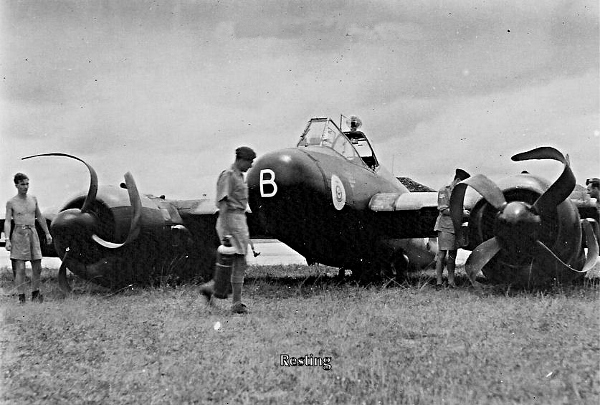
A replacement Brigand RH831 arrived on the Sqdn to become unserviceable after only one sortie due a selector valve failing. Two other Brigands became u/s due to various problems but one more plane was delivered on 21st Sept (RH832) Two more Brigands were written off during November 1950. One was the C.O.'s aircraft RH828 carrying out a flap-less landing with the pilot swinging off the runway thinking that the long grass would slow him down, unfortunately the plane ran into a ditch and one undercarriage Oleo went up through the wing.
The second was when the C.O. was taking off fully loaded in RH809 to carry out an air strike, just before he got airborne his 1,000lb bomb dropped off onto the runway bouncing up and hitting the underside of his fuselage just forward of the tailplane. The bomb did not explode but the Brigand was a 'write off'.
It was difficult to estimate how many bombs dropped onto the jungle exploded. On one airstrike alone whilst 16 bombs were dropped only 6 exploded.
Some of the bombs had the filling weeping out of the nose cone, a sticky mess and dangerous looking. On occasions when you had to drop them safe (if an airstrike was cancelled whilst you were airborne for example) we would drop them over the sea in the 'Strait of Malacca', occasionally some of these would still explode when they hit the water.
.On the first weekend of my Initial Training Course, it was very hot and a bunch of us 'raw' recruits were sitting on the grass by the river Nene in Peterborough wearing our new uniforms with our jacket unbuttoned and our hats in our pockets. A smartly dressed man and woman were walking their dog and as they passed us by, the man told us to get 'properly dressed', of course we responded with the usual answer. On the following Monday morning the Sqdn Leader Pilot in charge of our training course came into the lecture room to introduce himself and outline our programme for the next 6 months and lo and behold! it was the same chap who spoke to us that weekend!. Us offenders kept our heads down and he made no mention of the incident.
I only mention this because I have never been fond of being disciplined and took an immediate dislike to him - but the Gods are good sometimes - would you believe it - I met this couple again in Malaya whilst on a detachment to R.A.F. Butterworth on Sept 27th 1950. I was getting ready to go on my 23rd air-strike in the Termaloh area of Malaya with bombs rockets and 20mm cannons when this Sqdn Ldr who together with his wife were talking to the C.O. of Butterworth came up to us and asked if he could accompany us on our strike. We fitted him up with a parachute and flying helmet and away we went into the 'wide blue yonder'. The total time airborne was two hours and ten minutes including about thirty minutes to the target flying straight and level. Once I had identified our target we spent the next hour diving around to drop our bombs, then carrying out rocket attacks and finally going down low and using a lot of rudder to spray the area with cannon fire. During that hour our passenger lost the will to live, he was trying to hang his head out of the cockpit rear window to get rid of his dinner. We resumed our straight and level flight back to base, landed and taxied back to dispersal, he then crept out and fell into the arms of his wife. she only laughed at his very gray complexion and funny stagger.
During October 1950, Lincolns, together with Brigands from 45 and 84 Sqdn's. joined forces to plaster a jungle area in the Durian Tipus area. By this time we had become experienced in accurate dive bombing etc., and were able to plaster a given area of jungle.
Captured terrorists appeared stunned and their morale was at a low ebb. They said they didn't mind the bombs because they could shelter behind the trees but the cat like scream of the rockets (which were usually fired in salvo's of two's) really unnerved them.
|
|
I flew on my 46th air strike on Christmas Eve 1950. We then had Christmas Day and Boxing Day free. At 0830 hrs on December 27th I resumed flying, this time in Brigand VS861 to the 'Ruab' area of Malaya.
We were still having daily hydraulic pump and undercarriage selector problems which in effect meant that fewer Brigands were available for airstrikes.
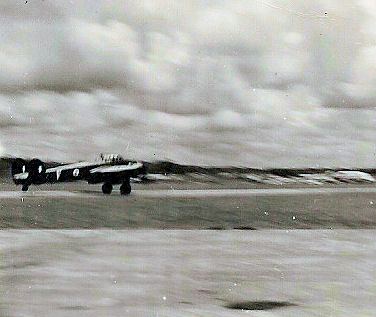
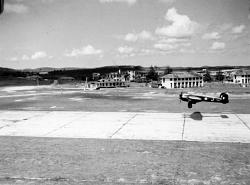
Brigands on Take Off Tengah

